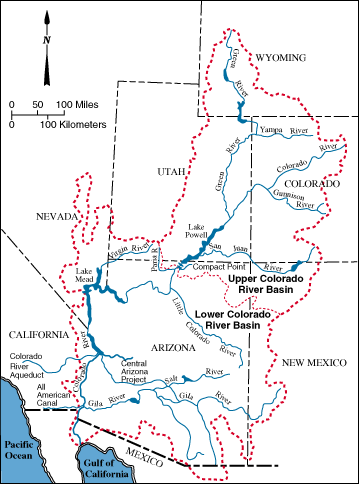The Ten Tribes Partnership and Water Marketing in the Colorado River Basin
Introduction
The Ten Tribes Partnership is a coalition of tribes coming together to advocate for a greater tribal voice in management of the Colorado River Basin. The Partnership has been active in advocating for fair treatment of tribal water rights in the Colorado River Basin.
The Ten Tribes Partnership is composed of a coalition of ten Colorado River Basin tribes who joined together to advocate for the tribes’ position in managing the Colorado River and its tributaries. Member tribes include the Chemehuevi Indian Tribe, the Cocopah Indian Community, the Colorado River Indian Tribes, the Fort Mojave Indian Tribe, the Jicarilla Apache Tribe, the Navajo Nation, the Northern Ute Tribe, the Quechan Indian Tribe, the Southern Ute Indian Tribe and the Ute Mountain Ute Indian Tribe.
Statement of Motivation
The Tribes perceive many threats to their rights and are very concerned that the operation of the River not interfere with their ability to put their rights to use on their reservations. One of the principal objectives of the partnership is to maximize on-reservation use of water, although some Tribes are willing to explore off-reservation use of tribal water.[1]
History of the Partnership
In 1992, a group of ten Colorado River Basin tribes joined forces to participate in Colorado River Basin water discussions. Their objective was simple: gain an equal seat at the bargaining table for discussions about Colorado River Basin issues. Collectively the Ten Tribes Partnership drafted a Position Paper of the Ten Indian Tribes with Water Rights in the Colorado River Basin.
The Tribes proposed a water banking arrangement that would draw on a variety of sources, including both the Tribes’ unused Winters entitlements and additional water made available from the fallowing land and conservation measures. The banked water would then be marketed to non-Indians. The Tribes’ proposal suggests the establishment of two water banks; one to serve the upper basin, and another to serve the lower basin.[2] Importantly, the options are designed for voluntary tribal transfers only and would not mandate transfers from any of the member Tribes.[3]
Setting the Stage for Negotiation
The Partnership has determined preconditions for future water marketing negotiations. First, the Partnership would like to “quantify with the assistance and cooperation of the states an available supply of unused or otherwise available tribal water.” Secondly, “water-short States and Tribes would determine among themselves how much water/ and under what terms, they would agree to lease from the water surplus.” After establishing this foundational information, the parties may engage in negotiations to determine appropriate lease terms
T he Partnership has expressed that it would be amenable to subjecting leases to approval by the Seven Basin States, the Colorado River Tribal Partnership, and the Secretary of the Interior. Through requiring this approval, it would be ensured that the leases would be consistent with the need of the states and the tribes to protect their water right allocations. Another suggestion was that the states and tribes could participate in the development of Basin wide procedures and conditions for leasing
The Ten Tribes Partnership and Water Marketing
During the Bureau of Reclamation’s Colorado River Basin Study, the Ten Tribes Partnership was vocal in expressing its wish to ensure that the BOR accurately represented the reserved rights of each of the member tribes in light of current use and future imbalances in the water supply and demand in the Basin. Writing to the BOR, the Partnership requested that the study “assess how voluntary transfers of tribal water might be used to assist in meeting future imbalances”[4] in the allocation of Colorado River Basin waters. Carefully qualifying that each tribe in the partnership has individual objectives, the Partnership notes that:
There are a number of voluntary tribal transfers which one or more of the Tribes are exploring, or may wish to explore, to utilize their water entitlements for the ultimate benefit of their members. The voluntary tribal transfers will likely include, but are not limited to, water banking, water marketing, leasing and forbearance agreements. These transfers could be to any existing user of Colorado River water without regard to geographic limits. The analysis should include the extent to which each Tribe’s ability to use its water rights on any of its lands without regard to State boundaries would assist in meeting demands in the Basin as a whole.
Essentially, the Partnership sent a clear message to the BOR that tribes are interested in specific research on potential market opportunities in the Colorado River Basin.[5] This message echoed the Partnership’s 1992 “Ten Tribes Water Marketing Proposal” detailing the tribes’ desire to engage in water marketing and establishing suggested parameters for doing so.
[1] Position Paper Of The Ten Indian Tribes with Water Rights In The Colorado River Basin. 1993. Accessed at http://archive.library.nau.edu/cdm/ref/collection/cpa/id/62200
[2] Getches, David H. Colorado River Governance: Sharing Federal Authority as an Incentive to Create a New Institution. University of Colorado Law Review. Summer 1997. Page 244
[3] In support their water marketing proposal, the Ten Tribes Partnership cites “successful water transfer arrangements in place in the Colorado River Basin involving tribal water and non-Indian communities” including an agreement with the Quechan Indian Tribe, on the one hand, and the states of California and Arizona and the Metropolitan Water District (MWD).
Ten Tribes Partnership’s Proposed Option: Voluntary Tribal Water Transfers. Letter to the Bureau of Reclamation. Page 3. Accessed at
http://www.usbr.gov/lc/region/programs/crbstudy/144_Voluntary_Tribal_Water_Transfers.pdf
[4] Ten Tribes Partnership’s Proposed Option: Voluntary Tribal Water Transfers. Letter to the Bureau of Reclamation. Page 2. Accessed at
http://www.usbr.gov/lc/region/programs/crbstudy/144_Voluntary_Tribal_Water_Transfers.pdf
[5] Ten Tribes Partnership’s Proposed Option: Voluntary Tribal Water Transfers. Letter to the Bureau of Reclamation. Page 3. Accessed at
http://www.usbr.gov/lc/region/programs/crbstudy/144_Voluntary_Tribal_Water_Transfers.pdf
